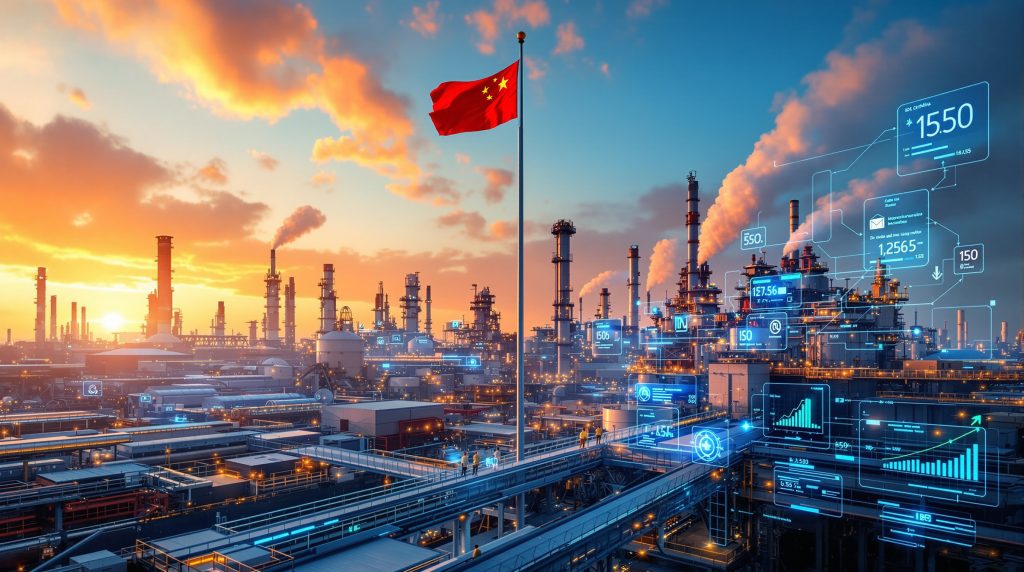Understanding China's Industrial Safety Revolution
China's manufacturing landscape has experienced a fundamental shift in workplace safety protocols over the past decade, with Baogang Group safety governance China serving as a prime example of this transformation. This evolution stems from comprehensive government mandates that integrate political accountability with operational performance metrics. State-owned enterprises like Baogang Group now operate under intensified oversight systems that combine traditional management structures with Party discipline frameworks.
The evolution reflects Beijing's commitment to what officials term "safe development principles," establishing new benchmarks for industrial governance. These changes extend beyond mere compliance, creating accountability chains that reach from executive boardrooms to factory floors across China's heavy industry sectors.
How Does China's Zero-Accident Policy Impact Major Corporations?
Political Accountability in Corporate Safety Management
Modern Chinese industrial governance represents a unique fusion of Party oversight and corporate management. Under current frameworks, executive performance evaluations directly incorporate safety metrics alongside traditional production targets. This dual accountability structure means corporate leaders face both professional consequences and potential political ramifications for safety failures.
The October 2025 Baogang Group Safety Committee meeting exemplified this approach, with Chairman Meng Fanying emphasizing that safety performance now constitutes an integral component of Party discipline evaluation. This integration creates powerful incentives for comprehensive safety compliance across all operational levels, reflecting the broader industry evolution trends transforming Chinese manufacturing.
The accountability framework operates through three distinct tiers:
- Corporate leadership: Bears political responsibility under Party evaluation criteria
- Line management: Maintains operational accountability with direct performance linkage
- Front-line workers: Holds position-specific safety obligations with individual metrics
National Directives Reshaping Industrial Culture
President Xi Jinping's safe development principles have fundamentally altered risk management approaches across Chinese heavy industry. These directives emphasize preventive measures over reactive responses, requiring companies to implement systematic hazard identification and mitigation protocols. Furthermore, China has tightened industrial oversight across state-owned enterprises, particularly during critical periods.
Baogang Group's recent policy changes illustrate this cultural transformation. Leadership now demands what they describe as transparent hazard reporting and continuous improvement cycles. The company has instituted protocols encouraging open communication about workplace risks, representing a significant departure from traditional hierarchical reporting structures.
This cultural shift addresses what Chairman Meng Fanying characterized as historical problems with complacency and luck-based thinking in industrial operations. The new framework requires workers at all levels to actively participate in hazard identification and prevention initiatives.
What Advanced Safety Technologies Are Chinese Giants Implementing?
Digital Monitoring and Real-Time Analytics
Chinese industrial corporations are deploying sophisticated technology systems to enhance workplace safety management. These implementations represent significant investments in digital infrastructure designed to reduce human error and improve emergency response capabilities. Consequently, these developments align with broader data-driven operations transforming industrial sectors worldwide.
Smart Safety Technology Implementation
| Technology Category | Application | Impact on Operations |
|---|---|---|
| Digital Monitoring | Real-time hazard detection | 24/7 automated surveillance systems |
| Data Analytics | Predictive risk assessment | Proactive intervention capabilities |
| Automation Systems | Reduced human error exposure | Enhanced emergency response protocols |
| Intelligent Controls | Integrated safety protocols | Streamlined operational oversight |
Baogang Group's intelligent safety initiative encompasses comprehensive digital monitoring systems that provide continuous hazard detection across mining, metallurgy, and rare-earth processing operations. These systems integrate sensor networks with centralised monitoring stations, enabling immediate response to developing safety concerns.
The data analytics component allows for predictive risk assessment, identifying patterns that may indicate emerging safety threats before they materialise into actual incidents. This proactive approach represents a significant advancement over traditional reactive safety management practices.
Integration of AI-Driven Risk Prevention
Artificial intelligence technologies are becoming central to Chinese industrial safety ecosystems. These systems enable predictive maintenance scheduling and automated threat detection across complex manufacturing operations. The AI integration allows for pattern recognition that can identify subtle indicators of equipment failure or process deviation. Additionally, AI-driven optimisation is becoming increasingly prevalent in industrial applications.
Modern safety education programmes now incorporate immersive simulation training, accident case studies, and real-time warning systems. This technological approach enables workers to experience realistic emergency scenarios without actual risk exposure, improving preparedness and response capabilities.
The automation systems reduce direct human exposure to hazardous processes whilst maintaining operational efficiency. These technologies represent substantial capital investments but offer long-term benefits through reduced incident rates and improved operational continuity.
How Do Multi-Layered Accountability Frameworks Function?
Corporate Leadership Responsibility Structure
China's industrial accountability systems create unprecedented executive responsibility for safety outcomes. Corporate leaders now face performance evaluations that weight safety metrics alongside traditional financial and production indicators. This structure ensures safety considerations receive executive-level attention and resource allocation.
The political dimension of this accountability extends beyond corporate governance into Party evaluation systems. Executives in state-owned enterprises must demonstrate safety leadership as part of their political advancement prospects, creating powerful incentives for comprehensive safety programme implementation.
Furthermore, these frameworks incorporate boosting safety operations as a core component of leadership evaluation criteria.
Key Insight: Contemporary Chinese industrial safety models integrate internationally recognised practices with vertically integrated Party-corporate structures, creating unique governance approaches that blend political and operational accountability.
Front-Line Worker Engagement Strategies
Modern safety culture emphasises worker participation in hazard identification and prevention activities. Companies like Baogang Group have implemented systems that encourage transparent hazard reporting and continuous improvement suggestions from all organisational levels.
The framework promotes what leadership describes as shared safety responsibility across the enterprise. This approach requires every worker to actively participate in prevention efforts rather than simply following prescribed safety procedures. Workers receive training in hazard recognition and are expected to contribute to ongoing safety improvement initiatives.
Inter-departmental coordination has been strengthened through refined reporting standards and improved communication protocols. These systems ensure that safety information flows efficiently between operational units and management levels, enabling rapid response to emerging concerns.
What Are the Global Supply Chain Implications?
Critical Materials Security and Stability
Enhanced safety protocols in Chinese industrial operations directly impact global supply chain reliability, particularly for rare earth elements and strategic materials. Baogang Group's position as China's largest steel producer and rare-earth ecosystem anchor makes its safety governance particularly significant for international manufacturers.
The systematic safety improvements suggest stronger supply continuity and reduced disruption risks for Western manufacturers dependent on Chinese critical materials. This stability becomes increasingly important as global supply chains face various geopolitical and operational pressures. Moreover, environmental concerns regarding heavy metal pollution have heightened international scrutiny of Chinese industrial operations.
The integration of digital monitoring and predictive analytics systems should theoretically reduce unplanned production interruptions caused by safety incidents. These improvements benefit not only Chinese operations but also international customers relying on consistent material supplies.
Western Manufacturing Dependencies
International manufacturers maintain significant reliance on Chinese industrial output for critical inputs across multiple sectors. The automotive industry depends on rare-earth elements for electric vehicle batteries and motors, whilst renewable energy systems require these materials for wind turbine magnets and solar panel components.
Defence applications also rely heavily on Chinese rare-earth supplies, creating strategic vulnerabilities that safety improvements may help mitigate. Enhanced operational stability in Chinese facilities reduces the risk of supply disruptions that could impact national security-related manufacturing.
The electronics industry represents another sector with substantial Chinese supply chain dependencies. Safety improvements in Chinese facilities contribute to more reliable component supplies for global technology manufacturers.
Why Are Environmental and Safety Standards Converging?
Ecological Civilisation Integration
China's environmental protection initiatives increasingly align with workplace safety protocols, reflecting broader national policy integration. The October 2025 Baogang Group meeting combined Safety and Environmental Committee functions, illustrating this convergence at the corporate level. This integration reflects trends toward modern ESG planning across industrial sectors.
This integration reflects China's ecological civilisation concept, which seeks to balance industrial development with environmental sustainability. Safety and environmental concerns often overlap in heavy industrial operations, making integrated management systems both practical and efficient.
The unified approach enables companies to address multiple regulatory requirements through coordinated management systems rather than separate compliance frameworks. This integration can reduce administrative overhead whilst improving overall risk management effectiveness.
Systematic Risk Management Approaches
Modern industrial governance addresses environmental and safety concerns through unified management systems that reflect broader national policy coordination. This systematic approach recognises the interconnected nature of workplace safety, environmental protection, and operational efficiency.
The integration enables more comprehensive risk assessment that considers both immediate safety threats and longer-term environmental impacts. This holistic approach may identify previously overlooked connections between different types of operational risks.
Companies can optimise resource allocation by addressing safety and environmental concerns through coordinated programmes rather than separate initiatives. This efficiency may provide competitive advantages whilst ensuring comprehensive risk management.
How Do Emergency Response Systems Operate?
Coordinated Multi-Department Protocols
Contemporary emergency management requires seamless coordination between operational units, safety departments, and regulatory oversight bodies. Baogang Group has implemented systems that tighten inter-unit coordination and refine reporting standards across all operational divisions.
The multi-department approach ensures that emergency responses can draw upon specialised expertise from different organisational units as situations require. This coordination enables more effective resource deployment during actual emergency situations.
Communication protocols have been standardised to ensure consistent information flow during emergency situations. These systems reduce response times and minimise confusion that might otherwise compromise emergency management effectiveness.
Continuous Training and Simulation Programmes
Advanced safety education incorporates immersive simulation training, accident case studies, and real-time warning systems to maintain preparedness levels across all organisational tiers. These programmes enable workers to practice emergency procedures without exposure to actual risks.
The training programmes utilise documented accident cases to illustrate potential failure modes and appropriate response procedures. This approach provides practical examples that help workers understand how theoretical safety principles apply in real-world situations.
Real-time warning systems complement training programmes by providing immediate alerts when hazardous conditions develop. These systems enable workers to apply their training in actual operational contexts, reinforcing learned behaviours through practical application.
What Role Does Technology Play in Cultural Transformation?
Digitisation of Safety Reporting
Electronic systems enable transparent hazard documentation and tracking, supporting cultural shifts toward open communication about workplace risks. Digital platforms provide mechanisms for workers to report safety concerns without traditional hierarchical barriers.
The digitisation process creates permanent records of safety interactions, enabling management to track patterns and identify systemic issues that might not be apparent through traditional reporting methods. This data-driven approach supports continuous improvement initiatives.
Technology systems can provide anonymous reporting options that encourage workers to communicate safety concerns without fear of retaliation. This capability supports the cultural transformation toward open safety communication that Chinese industrial leaders now emphasise.
Data-Driven Decision Making
Analytics platforms provide executives with comprehensive safety performance metrics, enabling evidence-based policy adjustments and resource allocation decisions. These systems transform safety management from intuitive approaches to quantitative analysis.
The data-driven approach enables management to identify trends and patterns that support proactive intervention rather than reactive responses to safety incidents. This capability aligns with national directives emphasising prevention over reaction in industrial safety management.
Performance metrics enable organisations to benchmark safety improvements and allocate resources to areas with the greatest potential for risk reduction. This optimisation approach maximises the effectiveness of safety investments whilst demonstrating continuous improvement.
How Are International Standards Being Adapted?
ISO Framework Integration
Chinese corporations increasingly adopt international safety management standards whilst maintaining alignment with domestic political and regulatory requirements. Baogang Group aims to institutionalise safety culture models that mirror ISO-aligned practices whilst operating through China's vertically integrated Party-corporate structure. This represents a key aspect of Baogang Group safety governance China adaptation to international norms.
This hybrid approach enables Chinese companies to meet international customer expectations whilst satisfying domestic political and regulatory requirements. The integration demonstrates China's commitment to international best practices whilst maintaining its unique governance characteristics.
ISO framework adoption facilitates international business relationships by providing common safety management languages and expectations. This standardisation reduces barriers for international customers evaluating Chinese suppliers.
Cross-Border Compliance Considerations
Global operations require navigation of multiple regulatory environments, creating complex compliance frameworks that balance local and international standards. Chinese companies with international operations must satisfy diverse regulatory requirements whilst maintaining domestic compliance.
The complexity of multi-jurisdictional compliance creates administrative challenges but also drives innovation in management systems that can accommodate diverse regulatory frameworks. These capabilities may provide competitive advantages in international markets.
Cross-border compliance requirements encourage adoption of best practices from multiple regulatory systems, potentially creating safety management capabilities that exceed any single jurisdiction's minimum requirements.
What Future Developments Can We Expect?
Emerging Technology Integration
Next-generation safety systems will likely incorporate advanced AI, IoT sensors, and predictive analytics to create even more sophisticated risk management capabilities. These technologies may enable real-time risk assessment and automated intervention systems.
Disclaimer: Future technology developments involve speculation based on current trends and announced initiatives. Actual implementation may differ from current projections due to technical, regulatory, or economic factors.
The integration of IoT sensor networks may enable continuous monitoring of equipment conditions, environmental factors, and worker activities. This comprehensive data collection could support increasingly sophisticated predictive analytics capabilities.
Policy Evolution and Industry Adaptation
Continued government emphasis on industrial safety will drive further innovation in corporate governance models and technology implementation strategies. Policy evolution may create additional requirements or incentives for safety technology adoption.
Disclaimer: Policy projections are based on current trends and official statements but actual government policy may evolve based on changing priorities, economic conditions, or international developments.
Industry adaptation to evolving safety requirements may accelerate technology development and create competitive advantages for early adopters. These dynamics could influence global industrial safety practices beyond China's borders.
Conclusion: The New Era of Industrial Governance
China's approach to industrial safety governance represents a significant evolution in corporate responsibility frameworks, combining traditional operational management with political accountability and advanced technology integration. This transformation extends far beyond domestic operations, influencing global supply chains and international manufacturing dependencies. The comprehensive changes in Baogang Group safety governance China exemplify broader systemic reforms across the nation's industrial sector.
The convergence of safety protocols, environmental standards, and political oversight creates unique governance models that international observers monitor closely. As these systems mature, they will likely influence global best practices in industrial risk management and corporate accountability.
Baogang Group's October 2025 Safety Committee meeting illustrates broader trends in Chinese industrial governance that blend international standards with domestic political structures. This hybrid approach may provide insights for other countries seeking to balance industrial development with comprehensive risk management.
The global implications of China's industrial safety evolution extend beyond supply chain stability to include potential influences on international safety standards and corporate governance practices. As Chinese companies expand internationally, their safety management approaches may increasingly interact with global industrial practices.
Disclaimer: This analysis is based on available information as of October 2025 and involves some forward-looking assessments that may not reflect actual future developments. Readers should verify current information and consider multiple perspectives when making business or investment decisions related to Chinese industrial operations or global supply chains.
Ready to Invest in the Next Major Mineral Discovery?
Discovery Alert instantly alerts investors to significant ASX mineral discoveries using its proprietary Discovery IQ model, turning complex mineral data into actionable insights. Understand why major mineral discoveries can lead to substantial market returns by exploring Discovery Alert's dedicated discoveries page, and begin your 30-day free trial today to position yourself ahead of the market.




